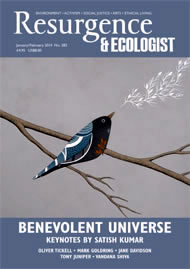This year is the 100th anniversary of a particular poet’s pilgrimage into Nature – on a bicycle. Edward Thomas cycled from Clapham south west into the countryside: the result was his book In Pursuit of Spring (1914).
David Caddy, the Dorset-based travel writer and editor of probably the best and most inclusive poetry and reviews journal in the UK, Tears in the Fence (established in 1984: the name refers to the fence at Greenham Common), is also a keen cyclist as well as a deeply rooted Nature poet, who decided to emulate Thomas’ journey a century later.
Thomas’ genius for detail, which made him such a fine critic as well as writer, is also naturally matched by Caddy’s eye for the living image, story, and memory. Cycling after Thomas and the English is also about our heritage, woven into and sometimes concealed in the landscape; and it is about that elusive thing, ‘being English’ – especially with reference to the radical and liberal tradition artists and writers naturally subscribe to.
Caddy weaves his narrative effortlessly between past and present, his 24-gear bike trailing Thomas on and off map references, and up and down roads with now vanished pubs (Thomas lists them as he goes). The result is both a Baedeker and a kaleidoscope of fascinating things where the pleasure of travelling and writing is palpable, heightened by the context of pilgrimage – a journey that is something much more than A to B.
It is a poet’s pilgrimage in, as Keats said, “this vale of soul-making”. Caddy begins and ends in Sturminster Newton, Dorset. The book starts with a brilliant chapter on the bicycle, and how it came into prominence as a result of the Suffragette movement, which saw women cycling to work. As he says, “the bicycle itself has a deep association with freedom and perspective”. And he quotes one character he meets as saying: “It’s something I worry about and the Government seems to be ignoring the liberties that our ancestors struggled for”.
That sense of liberty permeates the whole text, refreshing and generous as its author, who is open to meeting anyone and who trusts in the moment. Caddy’s grasp of Thomas himself is equally inclusive: an often moody man who had an abusive and belittling father, which (we might surmise) is what drove him to the front line… where he was killed by the vacuum created by a closely falling mortar shell – his body completely intact. He also brings to life the milieu Thomas moved in, which parallels the society of the best and most committed poets writing today, all of whom are equally alive spiritually, ecologically and politically.
Caddy writes: “The attachment to roots, place and ecology that one finds in Shakespeare, Blake, Wordsworth and Shelley has been increasingly sidelined by mechanistic thinking, policy making and by unethical business and banking practices that are underpinned by belief in a linear progress that is vehemently anti-community and anti-local”.
Caddy celebrates all that is not that in his discoveries and diversions, which include the origin of the picnic (at Box Hill), William Cobbett (the 18th-century sociologist on horseback), the cricket commentator and poet John Arlott, John Keats’ Ode to Autumn (drafted in Winchester), Graham Nash (of Crosby, Stills, Nash & Young) and the essayist William Hazlitt… along with numerous other references and thumbnail sketches.
The text itself is correspondingly non-linear, even as it traces a line in space. Its very form is the opposite of mechanistic. It couldn’t be further from a text book in that sense. It is a questing journey that turns up treasure: etymology and memory combine to show that what we need to remember is not only ancestry, not only literature even, but a living and lived example of what it means to be engaged and human.
I thoroughly enjoyed it, and I think you will, too.







